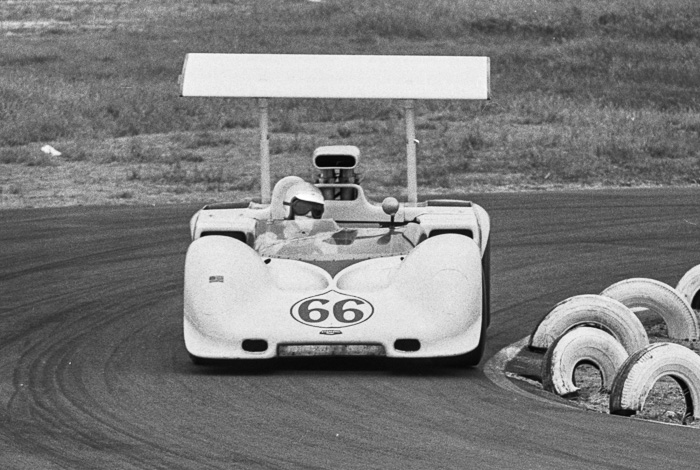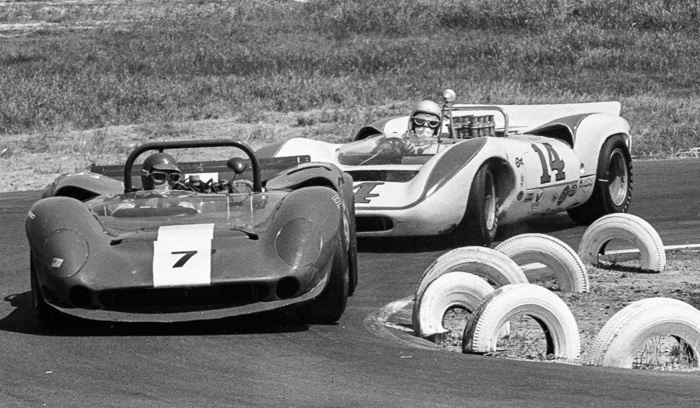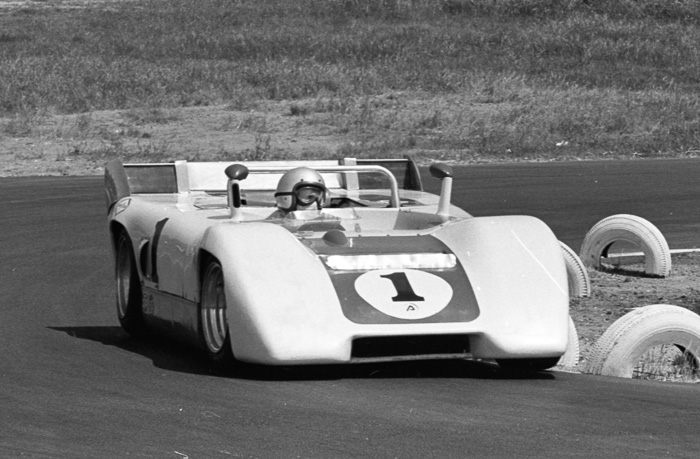The slowest corner at Laguna Seca is turn 11, a slightly-over-ninety-degree left that opens onto the main straight. Because there’s a fair amount on room on the outside, and you want to carry a lot of speed into the straight or you’ll pay for it for a long time, drivers often approach turn 11 with a certain amount of, well, exuberance. In 1968, the turn was number 9. Note the tires marking the apex.




Great series.
I grew up near Road America, and in the late 70’s and early 80’s and had the privilege of watching the tail end of the careers of some of the great drivers of the Can-Am era. To see them in their prime…too young, unfortunately. 🙁
Thanks for the trip down memory lane!
As a kid, I was obsessed with cars and racing cars, but I was too young to go to races on my own. I did get to see the Indy 500 a few times with my father (he was an executive with Borg Warner, so managed to get us VIP treatment, including pit and garage access, which was great), but I preferred roadracing and closed-wheel cars — especially Trans-Am cars! — to oval tracks and open-wheel cars.
One day, while out and about on my bicycle, I discovered the race car shop of Bob McKee in the next town over from where I lived. He designed and built the McKee (and later, Schkee) Can-Am cars there and I subsequently spent many afternoons sweeping the floor (literally!) and hanging out, watching the race cars being built and maintained. Never did get to see them race, though…
Your photos are great and I envy your ability to have taken them. I was also interested in motorcycles and did later get to photograph a few Trans-AMA motocross races and still have my Kodachrome slides around somewhere…
Anyway, thanks again for posting these!
Thanks, Jeffrey. You must be from Chicago. I grew up in Muncie,Indiana, but, except for nine months in Champagne-Urbana getting a MSEE, I decamped for Stanford and stayed close to Palo Alto until I retired.
One day, I think it was in the spring of ’68, but it could have been the fall of ’67, I was in The Camera Shop on Bryant Street in Palo Alto buying darkroom supplies. The staff there knew I was interested in auto racing, and introduced me to a guy named Tom Montgomery, who had a business called “Tom Montgomery Photo”. One of his clients was a tabloid called “Competition Press and Autoweek.” Tom did left coast sports car coverage for them on a contract basis. Tom wanted someone to take pictures for him so that he could get more coverage. He asked me if I’d do it. For nothing. I jumped at the chance.
Tom had a extensive collection of Nikon gear, including motor drive Nikon F bodies and lots of long lenses. He let me use what ever I wanted. He introduced me to all the corner workers and provided me with all-access press passes. I mostly did the spring and fall Can Am car events at Laguna Seca, which was a great track for photography, and, I now know, a great track to drive.
After a few years, Tom noticed that his photographs weren’t getting used by CP&AW much; they seemed to prefer mine. They were still credited to “Tom Montgomery Photo” though, so he sucked it up. Then Porsche came along and gave Mark Donohue a car so fast it stopped being a race and turned into a parade. It was all over.
Jim
Yes, my formative years were spent in Barrington and our backyard was right on the border with Palatine, which is where McKee’s shop was located. Although I was never able to persuade my father to go to any car races other than the Indy 500, a friend’s older brother was racing motocross most Sundays and I was able to tag along with him maybe a dozen times. I didn’t get to ride for free, though, as the deal we struck required me to photograph him while he was racing and give him three prints from the negatives he chose. He later pimped me to his friends, too, although I seem to recall getting paid something for those prints … good times!
I later got to photograph the Trans-AMA races after my father was transferred to Parkersburg, WV. I had my license by then so could drive to the tracks in Virginia, Pennsylvania, and Maryland on my own and with friends, usually camping overnight. I did sell one of my photos to Dirt Bike magazine for $5 and they included it in their annual “Crash and Burn” special issue, so I guess that’s when I turned pro … lol.
For my 13th birthday in 1972, my parents gave me subscriptions to both Competition Press and Autoweek and Cycle News, so if your photos were still being published then, it’s very likely I saw them. It is a small world, eh?